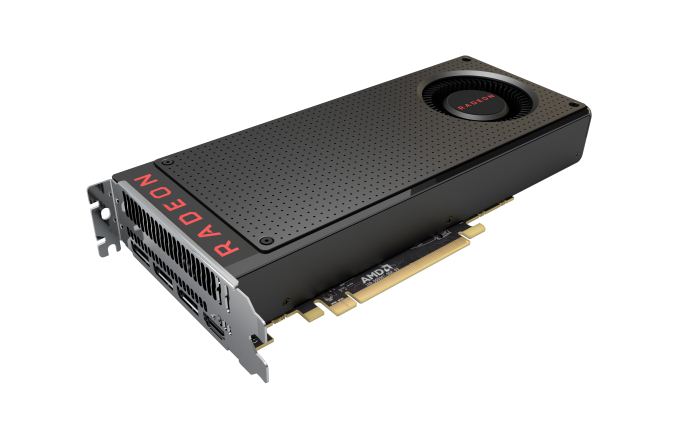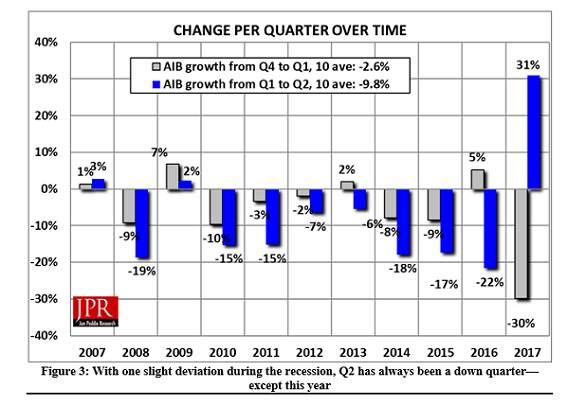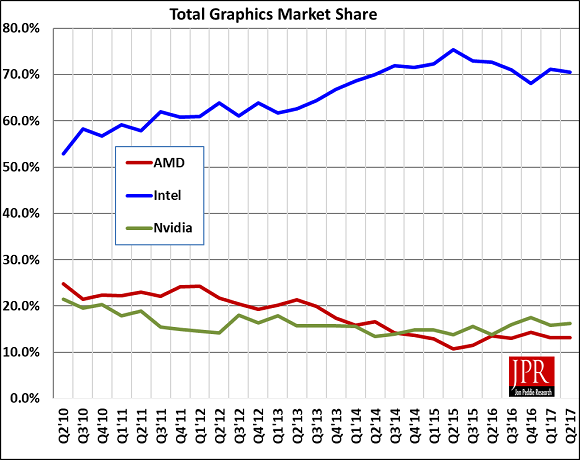Cryptomining Demand Drives Exceptionally High Graphics Card Shipments in Q2 2017
by Nate Oh on August 25, 2017 2:00 PM EST
This week, Jon Peddie Research (JPR) reported significantly higher discrete GPU shipments for Q2 2017, attributing the historically unprecedented increase to cryptocurrency mining, specifically to Ethereum mining. As opposed to the cryptocurrency mining demand of a few years ago, JPR notes that the ASIC-resistant nature of Ethereum mining has especially encouraged GPU mining. In terms of discrete desktop graphics market share, AMD gained a few percentage points from NVIDIA, bringing the current balance to AMD’s 29.4% versus NVIDIA’s 70.6%.
In context, the GPU and PC markets fluctuate in a relatively consistent seasonal pattern: shipments trend flat to down in Q1, notably down in Q2, notably up in Q3, and up to flat in Q4. According to JPR, Q2 2017 has seen an unprecedented 31% increase in discrete GPU shipments from Q1, the first time in over eight years that Q1-to-Q2 shipments have seen an increase at all. Discounting the minor increases during the recession, Q2 has always been the seasonally weak quarter for graphics card shipments.
Drawing a contrast to the limited Bitcoin and Litecoin mining impact on 2013 shipments, JPR identifies the memory-intensive Ethash, Ethereum’s hashing algorithm, as deterring ASIC development for Ethereum mining, and in turn any sudden GPU-displacing bust. That is, during the Bitcoin boom, low cost ASICs displaced GPUs. Consequently, JPR does not see a repeat of market cannibalization by used mining cards. While the diminishing return-on-investment (ROI) will eventually flatten out Ethermining-fueled GPU demand, this quarter saw a direct and significant Ethermining/cryptomining impact on discrete graphics demand.
On the back of that cryptomining demand, discrete GPUs have regained market share over integrated GPUs (iGPUs). Weak iGPU and desktop PC shipment numbers continue to reflect the overall declining PC market, while the high-end gaming PC sector continues to be the bright spot for the market. Overall, GPU shipments increased by 7.2% from last quarter.
Vendor-wise, JPR reports that AMD’s overall unit shipments increased 7.8% quarter-to-quarter, Intel’s shipments increased 6.3%, and NVIDIA’s shipments increased 10.4%. As mentioned earlier, AMD did gain market share in discrete desktop graphics, but still remains below last year’s market share level.
For AMD, their market share is back to Q2 2016 levels of around ~30%. The past year has seen launches of NVIDIA’s Pascal-based consumer cards, as well as of AMD’s Polaris-based RX 400 and 500 series cards; of the latter, the Polaris-based cards were explicitly a volume-play, and did not target the high-end market. To that end, the GTX 1070 and above did not have competition until this month, with AMD’s launch of RX Vega cards, and on the face of it, while Polaris has improved AMD's market share against NVIDIA, it has not made a dramatic difference. As the next few months roll on, the RX Vega cards, as well as Vega 11-based cards, will play a large role in AMD’s aspiring return to its historical 35% – 40% discrete desktop GPU market share.
For cryptomining demand, the remarkable impact on discrete graphics shipments does match up with general reports of mainstream graphics card shortages. When we looked at the discrete graphics market in Q2 and Q3 of 2016, the cryptocurrency mining demand then was nothing like this quarter. Now that the Ethereum mining mania has been quantified into numbers, it has revealed some of the context and reasoning behind cryptomining cards, cryptomining motherboards, and Radeon Pack bundles. And what the numbers reveal is that Ethereum GPU mining has been ridiculous in every sense of the word.
While Ethereum itself will die down eventually, it is anybody’s guess if GPU cryptomining booms will be firmly part of graphics card economics.
Source: Jon Peddie Research














46 Comments
View All Comments
Yojimbo - Friday, August 25, 2017 - link
Seasonal expectations from Q1 numbers would predict about 9 million desktop AIBs sold this past quarter. Instead about 13 million were sold. That suggests that 30% of desktop AIBs sold this past quarter are attributable to cryptocurrency mining, potentially more since elevated prices could be expected to reduce gaming demand. Then AMD's 29.4% market share suggests that either NVIDIA sold significantly more GPUs to cryptocurrency miners than AMD did during the quarter, or that AMD sold remarkably few cards to gamers during the quarter.eva02langley - Friday, August 25, 2017 - link
I don't know which numbers you are looking at. AMD stole 2% share from Nvidia without taking the fact of the frenzy in the used card market. The 290, 290x, 390, 390x, RX 470, RX 480, RX 570 and RX580 were all over the place at crazy prices while Nvidia were having the 1060 GTX and the 1070 GTX only for offering.Yojimbo - Friday, August 25, 2017 - link
I'm looking at the numbers posted in this article. I think I explained the analysis reasonably well. The 1.9% gain in market share is incredibly small if you consider the percentage of cards that were apparently sold to cryptocurrency miners. Also note that AMD's 29.4% market share is still historically low, and even 1.4% below their market share of Q2 just one year ago. If you have a specific question, just ask.As far as used cards, they are really besides my point. However, elevated prices for used AMD cards indicate that AMD cards that were previously sold to gamers were siphoned off from gaming to crypto miners. Do you really think during a cryptomining boom that accounted for a 40% seasonal rise in sales during a normally slow quarter for gaming, and additionally when the prices of used cards were elevated because of that boom, that more gamers bought used cards from cryptominers than cryptominers bought from gamers? That's completely illogical, especially when, as you yourself pointed out, GTX 1060 and GTX 1070 gaming alternatives exist for sale at much less elevated prices. Consider further that the 1060 and 1070 were already outselling AMD's offerings even when the AMD cards were selling for much less, before the cryptomining craze.
The logic of my conclusion is already sound, but its accuracy is verified by the latest Steam survey. AMD's 500 series GPUs have yet to show up at all on the survey, and the percentage of 480 and 470 cards has actually declined steadily on the survey from a high point in the April. The former shows that AMD has been selling few cards to gamers (the second alternative of my first post), and the latter shows that the used card market has been siphoning AMD cards away from gamers.
jjj - Friday, August 25, 2017 - link
Do note that it takes 3 months to react and up supply on an advanced node so Q2 just drained channel inventory ,there was no way for AMD and Nvidia to up supply.That's why share shifted little.
Yojimbo - Friday, August 25, 2017 - link
So what?jjj - Friday, August 25, 2017 - link
And i am supposed to take you seriously now?Do the math before you act like a Trump.
The impact was late in the quarter, prices and shortages scaled differently for the two and don't forget that gamers can be miners too.
Your theory does stand for Q3 and even Q4 if mining holds but it's nonsense for Q2.
Yojimbo - Friday, August 25, 2017 - link
My question has nothing to do with "math". It has to do with the relevance of what you said... hence "so what?" You never indicated what I said that you were referring to, or how what you said was relevant to whatever it was that I said that you were referring to.As far as the "math", I did do it. It's written out in my post. It stands on its own, regardless of your assertions about Q2, i.e., even if you are correct that Q3 and Q4 will be more affected by cryptocurrency than Q2, it does not make any difference. What I wrote is not a "theory", it is a statement based on the Q2 data. In Q2, AMD either sold remarkably few cards to gamers or they had well under 50% of the cryptocurrency market. The Steam survey suggests that there may have even been a net outflow of current generation AMD cards from the hands of gamers in the quarter, owing to the used card market. These conclusions are backed up by the common sense of who is and who is not willing to pay $375 for an RX 570.
Now quit acting like CNN and come into the world of facts and reality before you so stridently publicly declare things.
Samus - Sunday, August 27, 2017 - link
Every Microcenter I've walked in too, people are buying AMD cards for mining. It's ridiculous this is making a comeback. If you aren't going to use it for gaming (at all) just buy an ASIC for $400 and it will outperform any VEGA.Or just don't mine at all. The margins are so slim, depending on cost of investment, utility cost, time, wallet and currency conversion fees...I've done this before years ago it just wasn't worth it, even if you work in a large team to mine collectively.
wumpus - Thursday, August 31, 2017 - link
ASICs aren't ready for Etherium (one of the big places the action is, and what they are buying the cards for), and might never be. The real kick is memory bandwidth, and that is a lot trickier to get right than banging out shifts and lookups for SHA256. FPGA boards might have some pretty good memory interfaces, but they aren't likely to be sufficiently cost effective to beat an off the shelf GPU.Also, if anyone is making a profit off of mining VEGA, it is because of that HBM2 interface. I doubt it was intended for miners (bitcoin was likely the miners' darling when VEGA's interface was frozen), but that is how it worked out.
jjj - Friday, August 25, 2017 - link
Q2 is April -June and Ethereum went nuts in June so the impact on the quarter was limited.